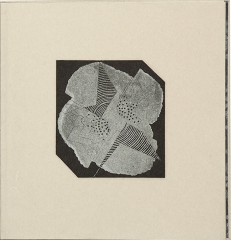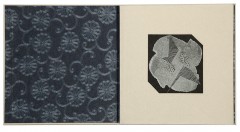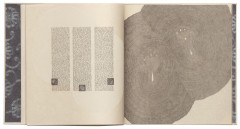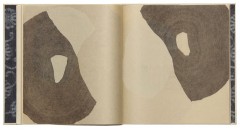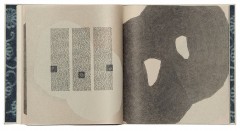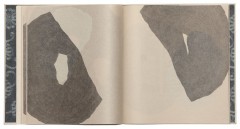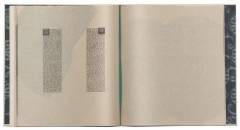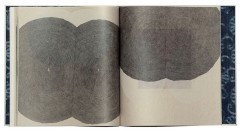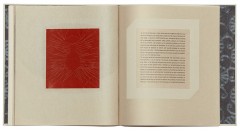GRÉGOIRE (Marie), RIGHI (François). Heures dispersées.
Ivoy-le-Pré, Les livres sont muets, 2014. In-8 (26 x 24,5 cm) de 32 pp. (16 ff. doubles dont 2 blancs), reliure à la chinoise, couverture muette, jaquette illustrée imprimée sur Japon Kawasaki, chemise et étui marouflé de Japon bleu nuit à décor moiré. 19 dessins et calligraphies de François Righi imprimés en lithographie par Michael Woolworth à Paris, et 3 eaux-fortes sur cuivre en taille d’épargne imprimées par l’artiste. Les textes, composés par François Righi en Antique Olive, ont été tirés par Émile Moreau à Henrichemont. 31 exemplaires, dont 3 hors-commerce, sur Japon Minota, numérotés et signés par l’auteur et l’artiste. Les 3 exemplaires de tête, accompagnés d’un cuivre gravé, sont épuisés (1 : Boreas Fine Art, Chicago, USA ; 2 : Koninklijke Bibliotheek, La Haye ; 3 : collection particulière, Nançay).
L’ouvrage est dédié à Robert Marteau, dont un vers est cité en épigraphe. Un feuillet volant est joint pour la traduction du texte de Marie Grégoire, en anglais par Jim Dening, en castillan par Mercè Artigas i Tarragona.
Épuisé (collection particulière, Douchy)
Ce livre est conçu dans la continuité de l’une des inflexions principales du travail de création de François Righi, qui tente d’inscrire l’un dans l’autre l’espace d’un lieu et celui d’un livre.
La « matière travaillée du corps de ce livre » se trouve à Bourges, à l’hôtel Lallemant. Le plafond à caissons, alternant emblèmes et putti, qui coiffe l’oratoire de cette demeure de la Renaissance, constitue la référence iconographique des dessins. Ceux des cernes du temps suivent les quatorze caissons décorés de putti. Le frontispice rappelle les seize caissons emblématiques qui firent l’objet du livre Le miroir volatil, de Robert Marteau, gravé, imprimé et publié par François Righi en 2004.
Les textes de Marie Grégoire placés aux deux extrémités du livre forment un diptyque.
Le premier, en ouverture, introduit au lieu à parcourir. Il suggère son ancrage historique, architectural et symbolique, où une allusion aux jeux d’enfants d’un autre temps n’a rien d’anodin.
Le second clôt le livre, en est le chant profond. La voix d’un auteur s’adresse à son inaccessible lecteur, dans une proximité paradoxale. Deux temporalités progressent en parallèle : écrire, lire. Les images du livre construisent des parcours en miroir. Le texte leur fait écho dans son propre registre. Dans tous les cas il est question de cheminement, de traversée, d’un devenir qui transforme au fil du temps, des pages, des mots.Marie-Jeanne Boistard
This book features drawings and thoughts inspired by the coffered ceiling in the oratory of the Hôtel Lallemant, a Renaissance-era building in Bourges. The recessed panels of this ceiling are decorated with alternating crest and cherub emblems, and each type of panel provides the inspiration for the various illustrations in this book. The fourteen coffers decorated with cherubs are the stimulus for Righi’s intricate drawings and calligraphies showing the circles of time, while the sixteen coffers decorated with crests are the inspiration for the engraved frontispiece. Two additional engravings further illustrate the book.
This volume is part of a larger trend in the Righi’s work, which in his own words, “attempts to inscribe one within the other the spaces of a place and of a book.” The coffered ceiling of the Hôtel Lallemant is also the subject of the book Le Miroir Volatil (2003), a collaboration between Righi and Robert Marteau.
The text for Heures Dispersées was set in Antique Olive and printed by Émile Moreau in Henrichemont. The full-page spreads of drawings were printed lithographically by Michael Woolworth in Paris. The engravings were printed in relief by the artist. This volume is stab sewn in the Eastern style with a wrapper of lightweight Eastern-made paper. It is protected by a chemise covered in light grey paper, which fits into a clamshell box covered in decorative, indigo-colored Eastern-made paper.
This deluxe edition is one of only 3 copies that are accompanied by an engraved copper plate used in the printing of the book. This copy includes the plate for the first print in the book which is featured on the book’s paper wrapper. The plate is mounted on a board lined with decorative, indigo-colored paper and is protected by a white facing mat. Housed in the box with the book, the mat is titled and signed by the artist below the plate.
The deluxe copy with the second plate has been acquired by the Koopman Collection of French books held by the National Library of the Netherlands. It, along with four other of Righi’s books recently traveled to the Grolier Club in New York where they were exhibited as part of the exhibition entitled “The Imaginative French Book in the 21st Century.”
This book was created in an edition of 31, with 3 copies hors commerce. This copy is numbered 1 and signed by the author and artist at the colophon.
Michael Thompson

